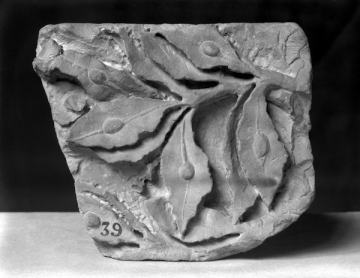Explore Collections


You are here:
CollectionsOnline
/
Fragment of a frieze or carved relief panel
Browse
Fragment of a frieze or carved relief panel
69-96 AD
Flavian
Flavian
Pavonazzetto marble
Height: 19.5cm
Width: 25cm
Thickness: 4cm
Width: 25cm
Thickness: 4cm
Museum number: S39
On display: Study
All spaces are in No. 13 Lincoln's Inn Fields unless identified as in No. 12, Soane's first house.
For tours https://www.soane.org/your-visit
Curatorial note
The leaves and branches of a carved bay-leaf ornamentation; probably a fragment of a not overly large frieze.
The type of foliage suggests deviation from architecture connected with the worship of Apollo. Compare the frieze fragments from the Temple of Apollo Sosianus (near the Theatre of Marcellus, Rome) for a larger, higher relief, parallel(?) to this fragment1 and especially the section of entablature once thought to be from the temple of Apollo Palatino, until recently in the Museo della Terme, and now in the Antiquario Palatino where it is mounted on the wall just to the left of the main entrance. Mrs. Strong followed the older tradition in associating it with the Augustan edifice2 , whereas actually this block appears to be Flavian and from the so-called Stadium nearby. The leaves show a higher degree of plasticity than the Soane fragment, but it is not impossible that the two may derive from the enrichment of the same edifice, since other Palatine fragments grace the Soane collection.
1Arch. Ang. 1941, cols. 508 ff. Fig.70.
2 E. Strong, La Scultura Romana...,1923, I, p. 63, fig. 40.
The type of foliage suggests deviation from architecture connected with the worship of Apollo. Compare the frieze fragments from the Temple of Apollo Sosianus (near the Theatre of Marcellus, Rome) for a larger, higher relief, parallel(?) to this fragment1 and especially the section of entablature once thought to be from the temple of Apollo Palatino, until recently in the Museo della Terme, and now in the Antiquario Palatino where it is mounted on the wall just to the left of the main entrance. Mrs. Strong followed the older tradition in associating it with the Augustan edifice2 , whereas actually this block appears to be Flavian and from the so-called Stadium nearby. The leaves show a higher degree of plasticity than the Soane fragment, but it is not impossible that the two may derive from the enrichment of the same edifice, since other Palatine fragments grace the Soane collection.
1Arch. Ang. 1941, cols. 508 ff. Fig.70.
2 E. Strong, La Scultura Romana...,1923, I, p. 63, fig. 40.
Rome; collected in Rome by Charles Heathcote Tatham for the architect Henry Holland during the 1790s. See Cornelius Vermeule, unpublished Catalogue of the Antiquities at Sir John Soane's Museum, Introduction, transcription of Tatham letters, List 3, no.56.
Literature
Tatham: Drawings, 11.
Soane collections online is being continually updated. If you wish to find out more or if you have any further information about this object please contact us: worksofart@soane.org.uk


